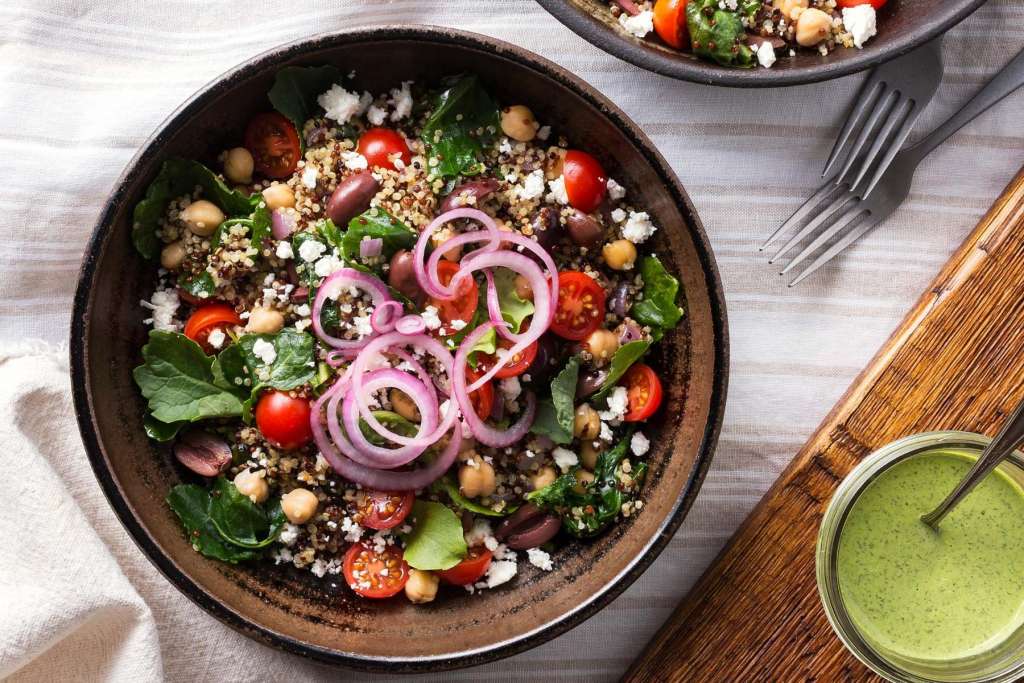Understanding Satiety

How do you find that sweet spot after a meal where you feel pleasantly full – like you’ve eaten enough without feeling stuffed? It may sound counterintuitive, but the first step is to stop restricting what you eat. When you honor your hunger, you’ll arrive at each meal ready to eat but not ravenous, and in a state of mind to take the time to be present, slow down, and eat mindfully.
Unsurprisingly it all comes down to what we put on our plates. Here, Sun Basket’s Director of Nutrition Lindsey Kane tells why and how to eat your fill.
1. All the nutrients
Blood levels of glucose (carbs), amino acids (protein), and fatty acids (fat) are constantly sending messages to the brain. A meal deficient in these nutrients won’t elicit the same degree of fullness that a well-balanced meal will. When these circulating levels are low, the hunger center in our brain goes on the hunt for more food.
2. Carbs crave company
Quick burning carbohydrates are digested faster than fat, protein, and fiber. Meals that combine these nutrients lead to a stronger sense of satisfaction.
3. Size matters
Not only does a high-volume meal make us feel physically full by taking up space, but as our stomach expands, it sends signals to the brain that lead to a sense of physiological fullness as well.
4. Solid = Gold
Do you ever feel hungry immediately after drinking a juice or a smoothie? Even though they may contain a long list of ingredients, drinks digest more quickly than solid foods. The process of chewing your food and having it churn in your stomach delivers a stronger sense of satisfaction than any liquid.
The good news is you don’t have to analyze each of these variables every time you sit down to eat. The simplest way to maximize satiety is to eat balanced meals with a variety of nutrient-rich, whole foods.
Whole foods naturally optimize each of these fullness factors: They’re rich in nutrients, and generally high in volume (fiber remains intact thanks to minimal processing). Enjoy a variety of whole foods and boom: you have a healthy balance of carbohydrates, protein, fat, and fiber so that both your gut and brain feel happy and nourished.
The other side to this is that processed foods tend to be low in volume (most of the fiber and bulk is stripped away), low in nutrients (most of the nutrients are lost during processing), and unbalanced. The ingredients are already mechanically broken down, which means that these foods are digested quickly, leaving us hungry and unsatiated minutes after eating.
The last piece of the satiation equation, and, probably the most important of all, is the satisfaction factor. Psychological fullness is as important as how full you feel physically and how your brain registers satisfaction. Studies have found that your perception about how filling you predict a food to be can impact how you feel after eating it. If you predict that the food on your plate isn’t going to fill you up, chances are you won’t be satisfied.
Pleasure matters, too. Foods that you genuinely enjoy activate the pleasure center in your brain, which releases dopamine and serotonin, the feel-good emotion, and in turn, delivers the optimal level of satisfaction. Have you ever forced yourself to eat leftovers that you just weren’t in the mood for, only to find yourself sniffing for something else minutes later? That’s the satisfaction factor at play. Technically you fed your body, but psychologically, it feels like something’s missing. The key to feeding your body and soul is to find nourishing foods that bring you joy.









